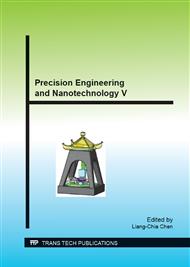[1]
Hongjie D, Eric W, Charles M. Lieber, Probing Electrical Transport in Nanomaterials: Conductivity of Individual Carbon Nanotubes, Science 1996; 272(26): 523-526.
DOI: 10.1126/science.272.5261.523
Google Scholar
[2]
T. W Ebbesen, Annu. Rev Mater. Sci. 24 (1994) 235.
Google Scholar
[3]
Dillon A. C., Jones K. M., Bekkedahl T. A., Kiang C. H., Bethune D. S., Heben M. J. Storage of hydrogen in single-walled carbon nanotubes , Nature 1997; 386: 377-379.
DOI: 10.1038/386377a0
Google Scholar
[4]
Farida D and Dominique L, Monte Carlo simulations of hydrogen adsorption in single-walled carbon nanotubes, J. Chem. Phys. 1998; 109(12): 4981-4984.
DOI: 10.1063/1.477109
Google Scholar
[5]
T. W. Ebbesen, H. J. Lezec, H. Hiura, J. W Bennett, H. F Ghaemi, T. Thio. Electrical conductivity of individual carbon nanotubes. Nature 1996 ; 382(6586): 54-56.
DOI: 10.1038/382054a0
Google Scholar
[6]
M. M. Treacy, T. W. Ebbesen, J. M. Gibson. exceptionally high Young's modulus observed for individual carbon nanotubes. Nature 1996; 381(20): 678- 680.
DOI: 10.1038/381678a0
Google Scholar
[7]
B. I. Yakobson, C. J. Brabec, J. Bernholc. Nanomechanics of Carbon Tubes: Instabilities beyond Linear Response. Phys Rev Lett 1996; 76(14): 2511-2514.
DOI: 10.1103/physrevlett.76.2511
Google Scholar
[8]
C. L. Zhang, H. S. Shen. Buckling and postbuckling analysis of single-walled carbon nanotubes in thermal environments via molecular dynamics simulation. Carbon 2006; 44(13): 2608–2616.
DOI: 10.1016/j.carbon.2006.04.037
Google Scholar
[9]
C. Q. Ru. Elastic buckling of single-walled carbon nanotube ropes under high pressure. Phys Rev B 2000; 62(15): 10405-10408.
DOI: 10.1103/physrevb.62.10405
Google Scholar
[10]
Chen T. L., Liu B., Wu J., Huang Y, Jiang H., Hwang K. C., J. Mech. Phys. of Solid. 2008; 56: 3224-3241.
Google Scholar
[11]
L. Dai, Intelligent Macromolecules for Smart Devices: From Materials Synthesis to Device Applications, Springer-Verlag, Germany, 2004 (ISBN:1852335106 ).
Google Scholar
[12]
J. P. Salvetat, J. M. Bonard, N. H. Thomson, A. J. Kulik, L. Forro, W. Benoit and L. Zuppiroli, Mechanical properties of carbon nanotubes, Applied Physics a-Materials Science & Processing 1999, 69:255-260.
DOI: 10.1007/s003390050999
Google Scholar
[13]
P. Calvert. Nanotube composites: A recipe for strength. Nature 1999; 399(6733): 210-211.
DOI: 10.1038/20326
Google Scholar
[14]
Robert J. Chen, Yuegang Z, Dunwei W, Hongjie D, Noncovalent Sidewall Functionalization of Single-Walled Carbon Nanotubes for Protein Immobilization, J. Am. Chem. Soc. 2011; 123(16): 3838-3839.
DOI: 10.1021/ja010172b
Google Scholar
[15]
Collins P. G. and Avouris P., Nanotubes for electronics, Sci. Am. 283, pp.38-45, (2000).
Google Scholar
[16]
Chopra, N.G., Benedict, L.X., Crespi, V.H., Cohen, M.L., Louie, S.G., Zettl, A., Fully collapsed carbon nanotubes, Nature 1995; 377(6545): 135-138.
DOI: 10.1038/377135a0
Google Scholar
[17]
Min-Feng Yu, Tomasz Kowalewski, and Rodney S. Ruoff, Structural Analysis of Collapsed, and Twisted and Collapsed, Multiwalled Carbon Nanotubes by Atomic Force Microscopy, Phys. Rev. Lett. 2001; 86(1): 87-90.
DOI: 10.1103/physrevlett.86.87
Google Scholar
[18]
Zhang P. H. and Crespi V. H., Phys. Rev. Lett. 1999; 83: 1791-1794.
Google Scholar
[19]
Rotkin V. and Gogotsi Y., Analysis of non-planar graphitic structures: from arched edge planes of graphite crystals to nanotubes, Mater. Res. Innovations 2002; 5(5): 191-200.
DOI: 10.1007/s10019-001-0152-4
Google Scholar
[20]
Rappè A. K., Casewit C. J., Colwell K. S., Goddard W. A. III, Skiff W. M., UFF, UFF, a Full Periodic Table Force Field for Molecular Mechanics and Molecular Dynamics Simulations, J. Am. Chem. Soc. 1992; 114(25) : 10024-10035.
DOI: 10.1021/ja00051a040
Google Scholar
[21]
J. M. Haile, Molecular Dynamics Simulation: Elementary Methods, John Wiley and Sons, New York, 1992 (ISBN: 0471819662).
Google Scholar
[22]
Müller-Plathe, F., J Chem. Phys., 1997; 106: 6082-6085.
Google Scholar
[23]
Clifford W. Padgett and Donald W. Brenner, Influence of Chemisorption on the Thermal Conductivity of Single-Wall Carbon Nanotubes, Nano Lett., 2004; 4(6): 1051-1053.
DOI: 10.1021/nl049645d
Google Scholar
[24]
Mar´ıa J. L´opez, Angel Rubio, and Julio A. Alonso, Deformations and Thermal Stability of Carbon Nanotube Ropes, arXiv 2003; cond-mat/0303648v1.
Google Scholar
[25]
Gang Wu, Baowen Li, Thermal rectification in carbon nanotube intramolecular junctions: Molecular dynamics calculations, arXiv 2007; 0707. 4241v1.
Google Scholar
[26]
Chun-Hung Chen and Yung-Chun Lee, Contact printing for direct metallic pattern transfer based on pulsed infrared laser heating, J. Micromech. Microeng. 2007; 17: 1252-1256.
DOI: 10.1088/0960-1317/17/7/006
Google Scholar
[27]
Robert E.T., Donald W.N., Bobby G.S. and Ralph C.M., Dynamics of flow inside carbon nanotubes, Nanotechnology 1997; 8: 112.
Google Scholar
[28]
Y. Quo, N Karasawa and W. A. Goddard, Prediction of fullerene packing in C60 and C70 crystals, Nature 1991; 351: 464-467.
DOI: 10.1038/351464a0
Google Scholar
[29]
R. Richert and A. Blumen, Disorder Effects on Relaxational Processes: Glasses, Polymers, Proteins, Springer Berlin, New York, 1994(ID: 10549360).
DOI: 10.1007/978-3-642-78576-4
Google Scholar
[30]
P. M. Ajayan, L. S. Schadler, C. Giannaris and A. Rubio, Adv. Mater. 2000; 12: 750.
Google Scholar
[31]
A. Allaoui, S. Bai, H. M. Cheng and J. B. Bai, Compos. Mechanical and electrical properties of a MWNT/epoxy composite. Sci. Technol. 2002; 62(15): 1993-(1998).
DOI: 10.1016/s0266-3538(02)00129-x
Google Scholar
[32]
S. U. S. Choi1, Z. G. Zhang2, W. Yu1, F. E. Lockwood2, and E. A. Grulke. Anomalous thermal conductivity enhancement in nanotube suspensions. Appl. Phys. 2001; Lett. 79: 2252-2254.
DOI: 10.1063/1.1408272
Google Scholar
[33]
M. J. Biercuk1, M. C. Llaguno1, M. Radosavljevic1, J. K. Hyun1, A. T. Johnson1, and J. E. Fischer. Carbon nanotube composites for thermal management. Appl. Phys. 2002; Lett. 80.
Google Scholar
[34]
Byeong-Woo Jeong, Jang-Keun Lim, and Susan B. Sinnott, Torsional stiffening of carbon nanotube systems, Appl. Phys. Lett. 2007; 91(9): 093102-093104.
Google Scholar
[35]
H. Allen, P. Bulson. Background to Buckling. London: McGraw-Hill; (1980).
Google Scholar
[36]
S. Timoshenko,J. Gere. Theory of Elastic Stability. New York: McGraw-Hill; (1988).
Google Scholar


